|
Monday, March 31, 2008
Progress Notes
One of the attractions at our museum which probably brings more visitors than any other
are the two log cabins located on the north side of the museum building. The smaller of
the two, known as the Williams Cabin (photo 01),
was brought to the museum grounds in the early 1990's.
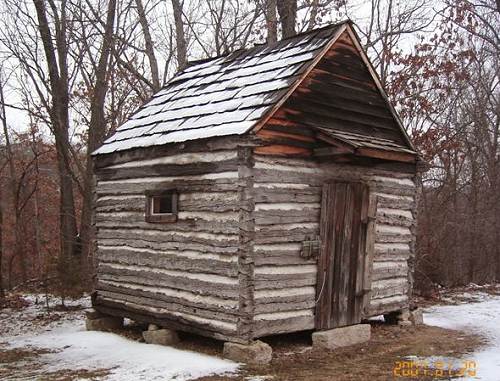
01 Williams Cabin on Museum Site
It had originally belonged to John Williams of Iberia and came from his farm
having been built for his two slaves in the mid 1800's. The cabin was moved from one place
to another on the farm at least twice. The Pemberton/Williams family donated it as well as
a large loom owned by John Williams to the museum in the early 1990's. Here is a photo of
the Williams Cabin on the original site just before it was removed from the Williams farm (photo 02).
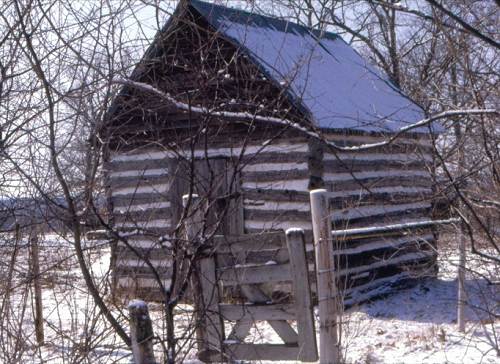
02 Williams Cabin at Original Location
The larger cabin on the museum property is known as the Peter Lupardus cabin (photo 03 cabin at museum site) and was
moved to the museum property in stages over several years from 1994 until 1997.
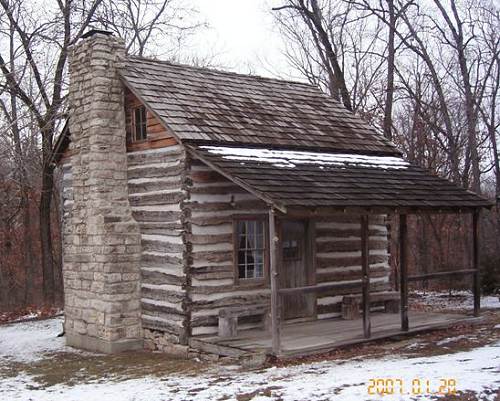
03 Lupardus Cabin at Museum
It was built in 1867. Here is a photo of it at its original site on the Lupardus
farm (photo 04). Through the years it
has had several owners after Peter Lupardus lived in it until Willard and Maggie Boyd
purchased it in the early 1940's leaving it to their grandson, Gary Flaugher, who
graciously donated it to the museum in the early 1990's.
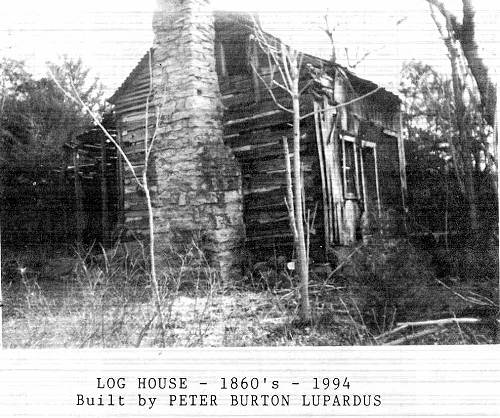
04 Old Photo of Lupardus Cabin
Carl McDonald, a member of our Miller County Historical Society, recruited
several family members who helped him over a period of three to four years disassemble it
and move it to Tuscumbia (photo 05 of family
members). The project was planned carefully by Carl even to the point of
numbering each log so that the reconstruction would be exact.

05 Work Crew
The common bond for all those who were interested in the project and helped with
it were descendents of Peter Lupardus (photo 06),
who had a total of thirteen children who lived with him and were raised in the cabin. In
this family photo taken in 1903 (photo 07)
many of his children and grandchildren are posing. Because he had so many children, many
people living here and elsewhere can find that one of their ancestors was a descendent of
Peter Lupardus and would have lived in the cabin.
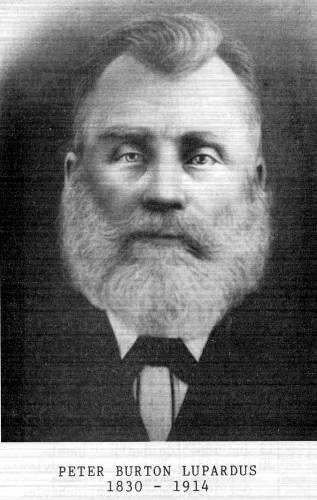
06 Peter Burton Lupardus
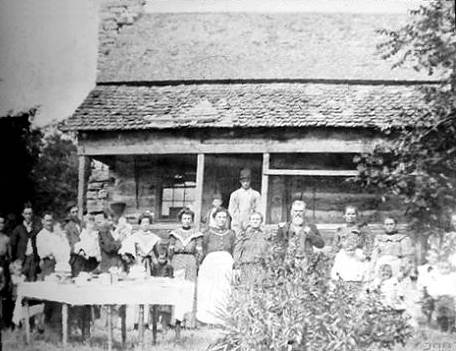
07 Lupardus Family Photo - 1903
All of us are very appreciative of the work that Carl McDonald has done over the
years for the historical society and the museum. In addition to the Herculean task of
moving the Lupardus cabin to the museum property, Carl has been a tireless volunteer
worker at all events and functions of the society and museum. Currently, he is a board
officer holding the position of Vice President. This last year, Carl has spent many hours
donating his personal labor helping with the wiring and other tasks required for our
building and renovation project for the museum. Here is a photograph and short biography
of Carl (photo 08):
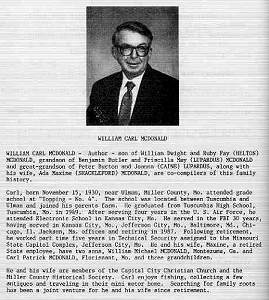
08 Carl McDonald
Click image for larger view
Willard and Maggie Boyd, who were the last occupants of the Lupardus cabin, were
my wife Judy's grandparents whom she, as well as her sisters and brother, visited often (photo 09 of Willard and Maggie in front of the cabin).
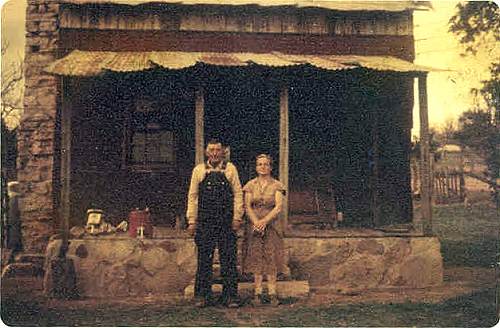
09 Willard and Maggie Boyd
She always remembered the fun she had playing in the fast moving stream which
came boiling up out of the ground at the head of a small valley on the farm (photo 10).
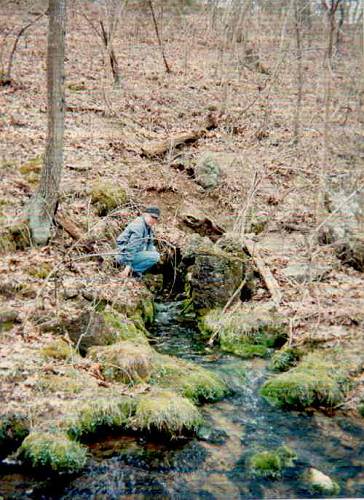
10 Cave Spring
Judy's sister, Sharon, who stayed overnight many times in the cabin, is very
familiar with it and because of that has enjoyed giving talks and presentations about her
memories of living in the old cabin. Sharon often is scheduled by school groups to give
the students a tour of the cabin (photo 11).
Any one who wants to take the tour can schedule it by calling the museum at 573 369 3500.
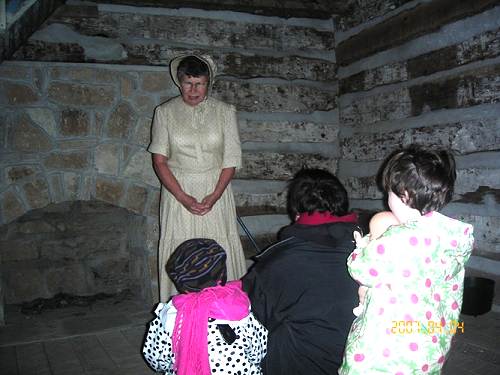
11 Sharon Steen Holder Telling Lupardus Cabin Story
The interesting thing about my wife Judy's family is that it has not only a
connection to the Lupardus cabin but also to the Williams cabin. Judy's sister, Sue,
described in some detail her memories of the two cabins in an article for the Autogram
several years ago:
Miller County Autogram
August 7, 1997
By Sue Steen Cates
Grandparents and log houses - they seem to go together for the
Steen siblings -- Don and his sisters, Sue Cates, Sharron Holder, Shirley Woolsey, Judy
Pryor and Janie Davis. The first log cabin given to the Miller County Historical Society
was from the farm of Frank and Ella Steen, the paternal grandparents of the above Steen
brother and sisters. Now the second one, from the farm of Willard and Maggie Boyd, their
maternal grandparents, is on site, having been recently put back together.
The Steen farm, located between Brumley and Iberia, had been
purchased by Ella Steen's grandfather, John Williams, in the 1850s when he moved his
family from Kentucky to Missouri. He built a house for his family and the log cabin for
Chaney and her little daughter, Easter - two blacks who moved with the Williams family.
Frank and Ella lived on that farm more than 60 years. During that time, lots of memories
were made for all of the grandchildren. Among those memories are week long stays during
the summer with Grandpa and Grandma, Steen cousins always there to play, a big grass yard,
lots of bright flowers, a cellar, a huge old tree in the yard, a cistern under the floor
of a side porch, geraniums in pots, an old trunk upstairs that held pictures, grandma's
round table that always managed to seat whomever was there at meal time, Grandma never
without her apron, a grandfather clock that chimed the hour (I always loved hearing it
during the night), feather mattresses thick enough to bury ourselves in, a cold chamber
pot at night, Aunt Icie's doll in the closet which was a forbidden item for us, and always
the log cabin.
The log cabin sat in the yard just behind the big house. It was
used for storage; but what a fun place to play. It was just one room, but had boards
nailed to form a ladder up to a little loft. If you got up there first, you could keep
anyone else from coming up! It smelled of grain and of leather. Grandpa had put up some
boards, forming a little grain bin, probably holding chicken feed. Old harnesses hung in
there along with the side saddle that belonged to Grandma. Her father, Floyd Wall, had
bought it for her in Brumley when she was about nine years old. Garden seed and tools were
kept in there. The foundation was made of stacked, real flat rocks. But years ago, this
had been the home of Chaney and her daughter Easter.
The second log house placed at the Historical Museum was built by
Peter Burton Lupardus in 1867 and his family of children was raised there. It sat on a
farm close to Ulman.
Willard and Maggie Boyd bought the farm in 1945 and lived there
until they moved to Ulman in 1958. They raised their grandson, Gary Flaugher, there, and
he owns the farm now.
Gary donated the cabin to the museum. The difficult meticulous
job of taking it down, numbering and ordering the logs, reassembling them on the museum
site, and recreating the fireplace was not done quickly. We will forever be grateful to
Carl McDonald and his brother Bert who headed up the team of volunteers that brought the
cabin to our museum site.
Again, summers meant week long stays at another wonderful cabin,
Grandpa and Grandma Boyd's. A lean-to kitchen and a large front porch had been added onto
the original house. It was heated with a wood stove sitting in the living room and Grandma
cooked with a big wood cook stove in the kitchen. The house had a full upstairs room, with
steep, narrow winding steps to get to it. On a rainy day, that was a great hide-a-way for
cousins! We could have secret meetings, read books, draw and color, sort through boxes of
famIly pictures or tell ghost stories. But if the weather was nice, all of the living was
done outside except to eat and sleep! What a wonderful place for carefree children. A
large flat rock bottom creek runs through the farm. The water was never deep, often the
bottom was slick with moss. At one place was a deep swimming hole - where Grandma always
warned us to be on the lookout for water moccasins! Out of the side of the hillside came
trickling cold spring water -- we called it the cave spring. Mint was always growing
around it -- -which we picked and chewed. Grandma did not have a refrigerator. She often
kept milk and butter at the cave spring sitting in the cold water.
A large barn provided us a hay loft to climb and play in. There
were always plenty of animals. Grandpa had fox hounds - seems there were always puppies.
Grandma had a milk cow. And they had work horses and riding horses. I remember finding a
fox den with babies and Grandma telling me to leave it alone or the mother fox would move
her babies.
Grandma was part of a community quilting club and sometimes I was
there when it was her turn to "have club". The ladies would arrive in the
morning, all bringing lots of good food. They would all work together on a quilt until
noon, when the men folks would also come to eat. Makeshift tables would be set up outside
in the yard where the food would be served.
This Grandma's yard was not filled with flowers. She ordered
exotic kinds of fowl from catalogues. So the yard was shared by bright colored chickens
and roosters and bantams and guineas and ducks -- and always puppies.
New log houses are going up today. We have seen a lot of them in
the southern edge of the Appalachian Mountains where we have lived in Georgia and
Mississippi. But will they ever have the memories that the pioneer ones did --when things
didn't mean very much but extended family relationships did?
Thanks Sue.
One of the subjects I will be discussing off and on will be the caves of Miller County.
A week or so ago I wrote about Indian Burial Cave, which was for a time a commercial cave.
Over time, Miller County has had five show caves: Ancient Grotto at Aurora Springs,
Flanders Cave located just a short distance south of Stark Caverns, Stark Caverns, Arrow
Point Cave (also known as Wright Cave) and Indian Burial cave. According to Dwight Weaver,
who recently finished a very interesting book on Missouri Caves (Missouri Caves In
History And Legend), Miller County has 63 recorded caves. You can purchase Dwight's
book directly if you wish by contacting him at dweaver@socket.net.
One cave which isn't discussed in the cave exploration literature but which has an
interesting story is Ferguson Cave near Iberia. We have quite a bit of information about
Squire John Ferguson on our website. You can find his biography under the letter
"F" if you go to "Yesterdays" at the top of the page then to "People" and
click on "F"
in the letter box. Or you can go directly to the site by clicking on the following and
scrolling halfway down the page:
http://www.millercountymuseum.org/people/bio_f.html
Another interesting item about John Ferguson is a letter he wrote to his uncle in
Scotland which you can find at this location on our website:
http://www.millercountymuseum.org/letters/letters_02.html
Nancy Thompson, our museum director, is a direct descendent of John Ferguson and has
written an interesting article about the Ferguson Cave accompanied by photos which I will
copy here:
FERGUSON CAVE
Squire John Ferguson's farm was south of Iberia in Miller
County, Missouri, a short distance off Missouri Highway 17, on what is now County Road
17-42. Before coming to the Ferguson farm, a private lane turns to the left and fords the Big
Tavern Creek. This crossing is popularly known as T's Ford (photo 12),
named for William Thomas "T" Ferguson, eldest son of Squire John Hunter
Ferguson.
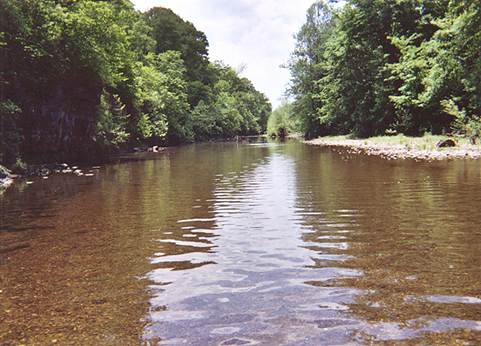
12 T's Ford Crossing
Up the creek a short distance are a series of caves
in a tall bluff above the creek. There is one large cave that goes back into the bluff for
quite a distance with smaller caves to either side, some of which are connected by small
passages (photo 13).
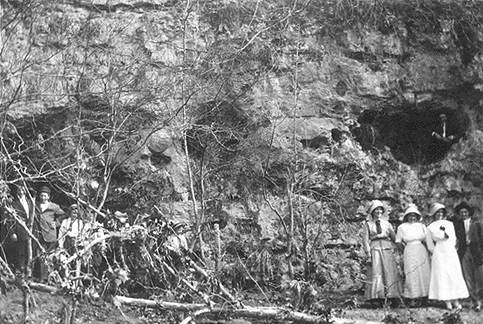
13 Bluff Caves
A small cave high on the bluff is easily visible
from the Tavern Creek. There is a much larger cave lower and to the left that is hidden
from view by trees and brush. This is the Ferguson Cave; it isn't
identified on any maps that I've seen (photo
14).

14 Ferguson Cave
Property on the hilltop above the bluff was
previously owned by William Thomas "T" Ferguson and is now part of a Missouri
Conservation wildlife preserve. The house has been removed, but the barn remains,
in poor repair (photo 15
and photo 16).
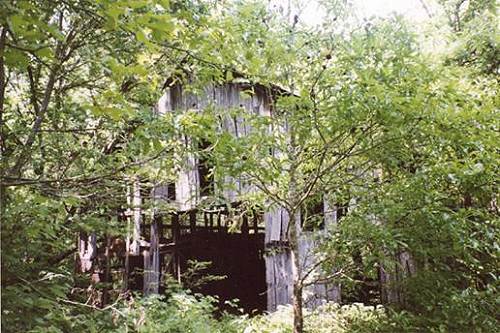
15 William Ferguson Barn

16 William Ferguson Well
The old well remains on the site where the
house stood. It is covered with a bucket.
John and Dorcas' farm was a short
distance further down County Road 17-42 toward the Madden Cemetery. The house remains but
is also in very poor repair. The son of the present owners of the property live in a
trailer set up behind the house.
We made this trip in 2004 and this house has since been
torn down (photo 17 and photo 18).
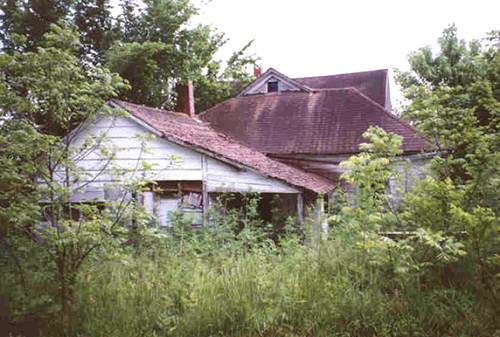
17 John and Dorcas Ferguson Home
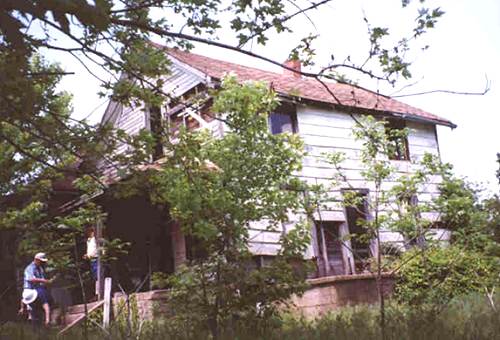
18 Ferguson Home
John Hunter Ferguson married Dorcas Cansada Shelton
on June 4, 1862 in Miller County, Missouri. He enlisted in Company M of the 3rd Regiment,
Missouri Cavalry Volunteers on October 15, 1862 and mustered out on July 27, 1865 at New
Orleans, LA.
East and North of Iberia were many Confederates and
Southern sympathizers; while to the West and Southwest the Radicals found much strength
among the Pennsylvanians having settled in the area before the war. An often-repeated
family story tells how, at the conclusion of the Civil War, the Confederates and Radicals
decided to have it out in the town of Iberia, but the Union boys, under Squire John, met
with the Confederates on the outskirts of the town and, after considerable bantering, they
withdrew without contest. However, things became so hot for Squire John that, for some
time, he sought refuge in this cave known as the "Ferguson Cave" to this day.
Family lore says his wife, Dorcas, slipped out at night and to bring him food, lowering
from above the cave it by rope. He survived the war, lived to a ripe old age and became a
very prominent figure in Miller County and the Iberia Community, active in religious,
political and community affairs (photo 19).
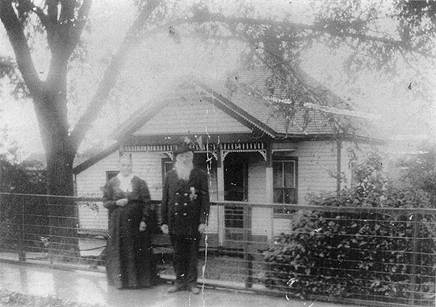
19 Ferguson Home
This house burned to the ground when a lantern
got tipped over. Grandma Arnold's house was later built on this site and utilized the
elevated concrete walk from the roadside sidewalk to her front porch. The house is 2-3
doors down from the Methodist Church. Squire John gave (or sold) the land to the Church to
build their building.
Thanks Nancy.
Our renovation project for the original museum building is progressing on schedule. I
have some optimism that it will be completed close to our opening day May 10 when we will
host an open house from 1:00 p.m. to 4:00 p.m. We have been busy making up the schedule
for those who wish to be hosts for guests and visitors to the museum. If you have an
interest in hosting a day at the museum call us and leave a message at 573 369 3500. It is
a wonderful opportunity to meet new friends as well as current friends who come to visit
and share common interests about the history of Miller County.
That's all for this week.
| 


